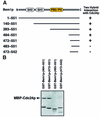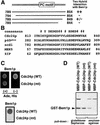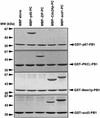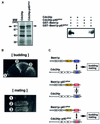Novel modular domain PB1 recognizes PC motif to mediate functional protein-protein interactions
- PMID: 11483497
- PMCID: PMC149144
- DOI: 10.1093/emboj/20.15.3938
Novel modular domain PB1 recognizes PC motif to mediate functional protein-protein interactions
Abstract
Modular domains mediating specific protein-protein interactions play central roles in the formation of complex regulatory networks to execute various cellular activities. Here we identify a novel domain PB1 in the budding yeast protein Bem1p, which functions in polarity establishment, and mammalian p67(phox), which activates the microbicidal phagocyte NADPH oxidase. Each of these specifically recognizes an evolutionarily conserved PC motif to interact directly with Cdc24p (an essential protein for cell polarization) and p40(phox) (a component of the signaling complex for the oxidase), respectively. Swapping the PB1 domain of Bem1p with that of p67(phox), which abolishes its interaction with Cdc24p, confers on cells temperature- sensitive growth and a bilateral mating defect. These phenotypes are suppressed by a mutant Cdc24p harboring the PC motif-containing region of p40(phox), which restores the interaction with the altered Bem1p. This domain-swapping experiment demonstrates that Bem1p function requires interaction with Cdc24p, in which the PB1 domain and the PC motif participate as responsible modules.
Figures








Similar articles
-
Structure and ligand recognition of the PB1 domain: a novel protein module binding to the PC motif.EMBO J. 2001 Aug 1;20(15):3947-56. doi: 10.1093/emboj/20.15.3947. EMBO J. 2001. PMID: 11483498 Free PMC article.
-
Structure and function of the PB1 domain, a protein interaction module conserved in animals, fungi, amoebas, and plants.Sci STKE. 2007 Aug 28;2007(401):re6. doi: 10.1126/stke.4012007re6. Sci STKE. 2007. PMID: 17726178 Review.
-
The solution structure of an N-terminally truncated version of the yeast CDC24p PB1 domain shows a different beta-sheet topology.FEBS Lett. 2005 Jul 4;579(17):3534-8. doi: 10.1016/j.febslet.2005.05.025. FEBS Lett. 2005. PMID: 15961083
-
The PB1 domain and the PC motif-containing region are structurally similar protein binding modules.EMBO J. 2003 Oct 1;22(19):4888-97. doi: 10.1093/emboj/cdg475. EMBO J. 2003. PMID: 14517229 Free PMC article.
-
[Structure and function of a novel domain, PB1--the role of PB1 domain in the signal transduction].Tanpakushitsu Kakusan Koso. 2002 Jun;47(8 Suppl):941-7. Tanpakushitsu Kakusan Koso. 2002. PMID: 12099044 Review. Japanese. No abstract available.
Cited by
-
Isolation and characterization of YlBEM1, a gene required for cell polarization and differentiation in the dimorphic yeast Yarrowia lipolytica.Eukaryot Cell. 2002 Aug;1(4):526-37. doi: 10.1128/EC.1.4.526-537.2002. Eukaryot Cell. 2002. PMID: 12456001 Free PMC article.
-
Inhibitory GEF phosphorylation provides negative feedback in the yeast polarity circuit.Curr Biol. 2014 Mar 31;24(7):753-9. doi: 10.1016/j.cub.2014.02.024. Epub 2014 Mar 13. Curr Biol. 2014. PMID: 24631237 Free PMC article.
-
Roles for the canonical polarity machinery in the de novo establishment of polarity in budding yeast spores.bioRxiv [Preprint]. 2025 Jan 6:2024.08.29.610423. doi: 10.1101/2024.08.29.610423. bioRxiv. 2025. Update in: Mol Biol Cell. 2025 Mar 01;36(3):ar28. doi: 10.1091/mbc.E24-07-0303. PMID: 39257763 Free PMC article. Updated. Preprint.
-
Symmetry-breaking polarization driven by a Cdc42p GEF-PAK complex.Curr Biol. 2008 Nov 25;18(22):1719-26. doi: 10.1016/j.cub.2008.09.060. Epub 2008 Nov 13. Curr Biol. 2008. PMID: 19013066 Free PMC article.
-
p21-activated kinases Cla4 and Ste20 regulate vacuole inheritance in Saccharomyces cerevisiae.Eukaryot Cell. 2009 Apr;8(4):560-72. doi: 10.1128/EC.00111-08. Epub 2009 Feb 13. Eukaryot Cell. 2009. PMID: 19218422 Free PMC article.
References
-
- Ago T., Nunoi,H., Ito,T. and Sumimoto,H. (1999) Mechanism for phosphorylation-induced activation of the phagocyte NADPH oxidase protein p47phox: triple replacement of serines 303, 304, 328 with aspartates disrupts the SH3 domain-mediated intramolecular interaction in p47phox, thereby activating the oxidase. J. Biol. Chem., 274, 33644–33653. - PubMed
-
- Butty A.-C., Pryciak,P.M., Huang,L.S., Herskowitz,I. and Peter,M. (1998) The role of Far1p in linking the heterotrimeric G protein to polarity establishment proteins during yeast mating. Science, 282, 1511–1516. - PubMed
-
- Chang E.C., Barr,M., Wang,Y., Jung,V., Xu,H.-P. and Wigler,M.H. (1994) Cooperative interaction of S.pombe proteins required for mating and morphogenesis. Cell, 79, 131–141. - PubMed
Publication types
MeSH terms
Substances
LinkOut - more resources
Full Text Sources
Molecular Biology Databases
Miscellaneous

